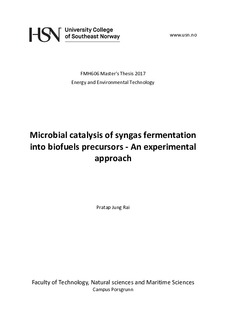| dc.description.abstract | Search for environment-friendly sustainable energy sources is of global interest due to continuous depletion of fossil fuels resources and excessive carbon dioxide emissions. Syngas fermentation is one of the promising sustainable alternative for liquid biofuel and chemical production from energy content wastes/byproducts. This study mainly focuses on acetic acid and ethanol production via fermentation, using hydrogen and carbon dioxide as substrates to mimic syngas. A laboratory scale, batch fermentation was performed at different headspace pressure ranged from 0.29 to 1.51 bar, 1200 rpm stirrer speed, and 22±1.4ºC.
Formation of acetic acid and ethanol were found significant. The maximum acetic acid concentration 68 mmol/L was obtained at 1176 hours and 1.12 bar headspace pressure. However, maximum ethanol concentration of 15 pA*s was found at 1297 hours and 1.51 bar headspace pressure. Ethanol consumption was observed during first 553 hours. Maximum H2 consumption rate was 0.153 mmol/h·gVS during 478-527 hours at 1.12 bar headspace pressure, which was 51 times higher than that obtained during first 71 hours at 0.29 bar headspace pressure (0.003 mmol/h· gVS). The total consumed hydrogen gas measure as COD (CODHydrogen) was equivalent to the increase in bulk liquid COD, 11.02 gCOD and 11.44 gCOD; in which 68% of CODHydrogen was converted to acetic acid (7.44 gCOD). A significant influence of headspace pressure and dissolved hydrogen concentration were observed on the volumetric mass (H2) transfer coefficient (kLa) and the solubility of hydrogen in the inoculum (CH). The maximum kLa and CH of 0.082 h-1 (R2 = 0.995) and 1.2 10-3 mol/L were found at 1.12 bar headspace pressure and 89 mmol/L dissolved hydrogen concentration, respectively. The calculated biomass yields ranged from 0.001-0.066 and 0.001-0.059 gVSS/gCOD, for acetic acid and ethanol formation, respectively, when the assumption of free energy efficiency use in growth was changed from 0.1 to 1.
Acetic acid and ethanol were dominant final product whereas other organic acids were almost constant and insignificant throughout the experiment. This implies that the microbial fermentation of hydrogen and carbon dioxide at headspace pressure ranged from 0.29-1.51 bar, 1200 rpm stirrer speed, and 22±1.4ºC, can be performed with digested food waste sludge for efficient acetic acid and ethanol production. | nb_NO |
